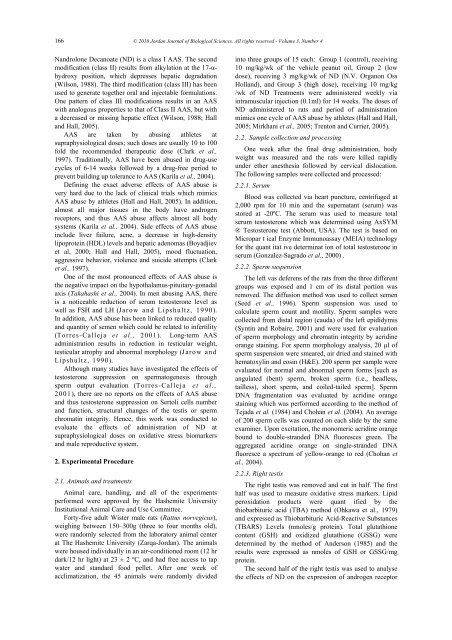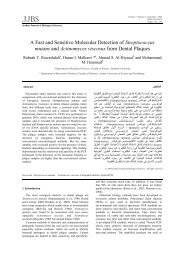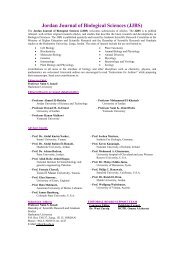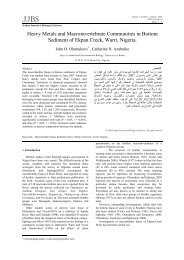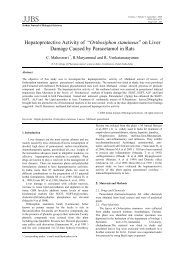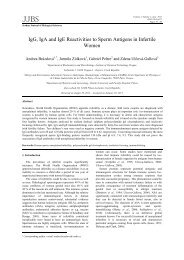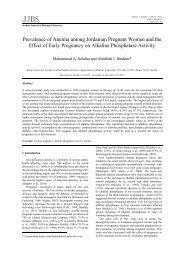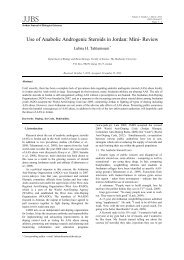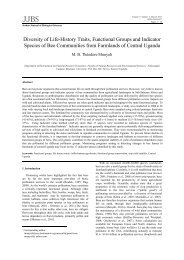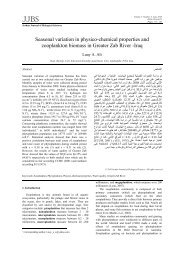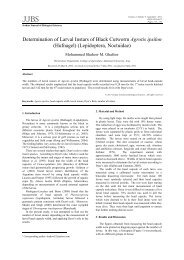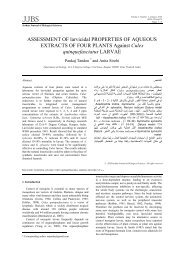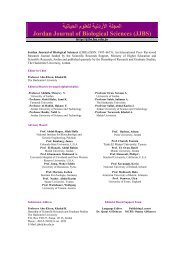Number 4 - Jordan Journal of Biological Sciences
Number 4 - Jordan Journal of Biological Sciences
Number 4 - Jordan Journal of Biological Sciences
You also want an ePaper? Increase the reach of your titles
YUMPU automatically turns print PDFs into web optimized ePapers that Google loves.
166<br />
© 2010 <strong>Jordan</strong> <strong>Journal</strong> <strong>of</strong> <strong>Biological</strong> <strong>Sciences</strong>. All rights reserved - Volume 3, <strong>Number</strong> 4<br />
Nandrolone Decanoate (ND) is a class I AAS. The second<br />
modification (class II) results from alkylation at the 17-αhydroxy<br />
position, which depresses hepatic degradation<br />
(Wilson, 1988). The third modification (class III) has been<br />
used to generate together oral and injectable formulations.<br />
One pattern <strong>of</strong> class III modifications results in an AAS<br />
with analogous properties to that <strong>of</strong> Class II AAS, but with<br />
a decreased or missing hepatic effect (Wilson, 1988; Hall<br />
and Hall, 2005).<br />
AAS are taken by abusing athletes at<br />
supraphysiological doses; such doses are usually 10 to 100<br />
fold the recommended therapeutic dose (Clark et al.,<br />
1997). Traditionally, AAS have been abused in drug-use<br />
cycles <strong>of</strong> 6-14 weeks followed by a drug-free period to<br />
prevent building up tolerance to AAS (Karila et al., 2004).<br />
Defining the exact adverse effects <strong>of</strong> AAS abuse is<br />
very hard due to the lack <strong>of</strong> clinical trials which mimics<br />
AAS abuse by athletes (Hall and Hall, 2005). In addition,<br />
almost all major tissues in the body have androgen<br />
receptors, and thus AAS abuse affects almost all body<br />
systems (Karila et al., 2004). Side effects <strong>of</strong> AAS abuse<br />
include liver failure, acne, a decrease in high-density<br />
lipoprotein (HDL) levels and hepatic adenomas (Boyadjiev<br />
et al, 2000; Hall and Hall, 2005), mood fluctuation,<br />
aggressive behavior, violence and suicide attempts (Clark<br />
et al., 1997).<br />
One <strong>of</strong> the most pronounced effects <strong>of</strong> AAS abuse is<br />
the negative impact on the hypothalamus-pituitary-gonadal<br />
axis (Takahashi et al., 2004). In men abusing AAS, there<br />
is a noticeable reduction <strong>of</strong> serum testosterone level as<br />
well as FSH and LH (Jarow and Lipshultz, 1990).<br />
In addition, AAS abuse has been linked to reduced quality<br />
and quantity <strong>of</strong> semen which could be related to infertility<br />
(Torres-Calleja et al., 2001). Long-term AAS<br />
administration results in reduction in testicular weight,<br />
testicular atrophy and abnormal morphology (Jarow and<br />
Lipshultz, 1990).<br />
Although many studies have investigated the effects <strong>of</strong><br />
testosterone suppression on spermatogenesis through<br />
sperm output evaluation (Torres-Calleja et al.,<br />
2001), there are no reports on the effects <strong>of</strong> AAS abuse<br />
and thus testosterone suppression on Sertoli cells number<br />
and function, structural changes <strong>of</strong> the testis or sperm<br />
chromatin integrity. Hence, this work was conducted to<br />
evaluate the effects <strong>of</strong> administration <strong>of</strong> ND at<br />
supraphysiological doses on oxidative stress biomarkers<br />
and male reproductive system.<br />
2. Experimental Procedure<br />
2.1. Animals and treatments<br />
Animal care, handling, and all <strong>of</strong> the experiments<br />
performed were approved by the Hashemite University<br />
Institutional Animal Care and Use Committee.<br />
Forty-five adult Wister male rats (Rattus norvegicus),<br />
weighing between 150–300g (three to four months old),<br />
were randomly selected from the laboratory animal center<br />
at The Hashemite University (Zarqa-<strong>Jordan</strong>). The animals<br />
were housed individually in an air-conditioned room (12 hr<br />
dark/12 hr light) at 23 ± 2 ºC, and had free access to tap<br />
water and standard food pellet. After one week <strong>of</strong><br />
acclimatization, the 45 animals were randomly divided<br />
into three groups <strong>of</strong> 15 each: Group 1 (control), receiving<br />
10 mg/kg/wk <strong>of</strong> the vehicle peanut oil, Group 2 (low<br />
dose), receiving 3 mg/kg/wk <strong>of</strong> ND (N.V. Organon Oss<br />
Holland), and Group 3 (high dose), receiving 10 mg/kg<br />
/wk <strong>of</strong> ND Treatments were administered weekly via<br />
intramuscular injection (0.1ml) for 14 weeks. The doses <strong>of</strong><br />
ND administered to rats and period <strong>of</strong> administration<br />
mimics one cycle <strong>of</strong> AAS abuse by athletes (Hall and Hall,<br />
2005; Mirkhani et al., 2005; Trenton and Currier, 2005).<br />
2.2. Sample collection and processing<br />
One week after the final drug administration, body<br />
weight was measured and the rats were killed rapidly<br />
under ether anesthesia followed by cervical dislocation.<br />
The following samples were collected and processed:<br />
2.2.1. Serum<br />
Blood was collected via heart puncture, centrifuged at<br />
2,000 rpm for 10 min and the supernatant (serum) was<br />
stored at -20ºC. The serum was used to measure total<br />
serum testosterone which was determined using AxSYM<br />
® Testosterone test (Abbott, USA). The test is based on<br />
Micropar t ical Enzyme Immunoassay (MEIA) technology<br />
for the quant itat ive determinat ion <strong>of</strong> total testosterone in<br />
serum (Gonzalez-Sagrado et al., 2000) .<br />
2.2.2. Sperm suspension<br />
The left vas deferens <strong>of</strong> the rats from the three different<br />
groups was exposed and 1 cm <strong>of</strong> its distal portion was<br />
removed. The diffusion method was used to collect semen<br />
(Seed et al., 1996). Sperm suspension was used to<br />
calculate sperm count and motility. Sperm samples were<br />
collected from distal region (cauda) <strong>of</strong> the left epididymis<br />
(Syntin and Robaire, 2001) and were used for evaluation<br />
<strong>of</strong> sperm morphology and chromatin integrity by acridine<br />
orange staining. For sperm morphology analysis, 20 µl <strong>of</strong><br />
sperm suspension were smeared, air dried and stained with<br />
hematoxylin and eosin (H&E). 200 sperm per sample were<br />
evaluated for normal and abnormal sperm forms [such as<br />
angulated (bent) sperm, broken sperm (i.e., headless,<br />
tailless), short sperm, and coiled-tailed sperm]. Sperm<br />
DNA fragmentation was evaluated by acridine orange<br />
staining which was performed according to the method <strong>of</strong><br />
Tejada et al. (1984) and Chohan et al. (2004). An average<br />
<strong>of</strong> 200 sperm cells was counted on each slide by the same<br />
examiner. Upon excitation, the monomeric acridine orange<br />
bound to double-stranded DNA fluoresces green. The<br />
aggregated acridine orange on single-stranded DNA<br />
fluoresce a spectrum <strong>of</strong> yellow-orange to red (Chohan et<br />
al., 2004).<br />
2.2.3. Right testis<br />
The right testis was removed and cut in half. The first<br />
half was used to measure oxidative stress markers. Lipid<br />
peroxidation products were quant ified by the<br />
thiobarbituric acid (TBA) method (Ohkawa et al., 1979)<br />
and expressed as Thiobarbituric Acid-Reactive Substances<br />
(TBARS) Levels (nmoles/g protein). Total glutathione<br />
content (GSH) and oxidized glutathione (GSSG) were<br />
determined by the method <strong>of</strong> Anderson (1985) and the<br />
results were expressed as nmoles <strong>of</strong> GSH or GSSG/mg<br />
protein.<br />
The second half <strong>of</strong> the right testis was used to analyse<br />
the effects <strong>of</strong> ND on the expression <strong>of</strong> androgen receptor


